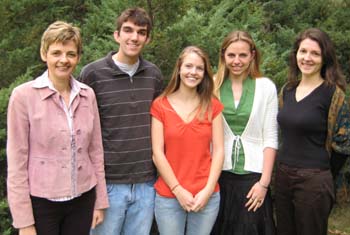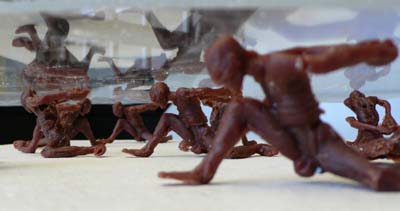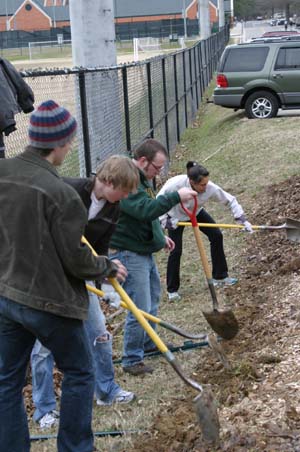That Thing You Do
Student and faculty shorts
 Senior AJ Dronkers spent the summer working
for Fraser Communications, a California advertising agency whose
clients have included United Way, Toyota, the L.A. Department of Public
Health, Aids Healthcare Foundation and the state of California. One of
the huge projects they directed was the "Flex Your Power" campaign of
California, to create awareness about how to save energy and encourage
citizens to reduce energy use. Another project they took on was for the
Metropolitan Water Districts. They did campaigns to help reduce water
usage creating spots that showed for example what plant species are
native to southern California and require little or no watering.
Towards the end of the summer the agency was moving locations and was
trying to get their new building LEED certified.
Senior AJ Dronkers spent the summer working
for Fraser Communications, a California advertising agency whose
clients have included United Way, Toyota, the L.A. Department of Public
Health, Aids Healthcare Foundation and the state of California. One of
the huge projects they directed was the "Flex Your Power" campaign of
California, to create awareness about how to save energy and encourage
citizens to reduce energy use. Another project they took on was for the
Metropolitan Water Districts. They did campaigns to help reduce water
usage creating spots that showed for example what plant species are
native to southern California and require little or no watering.
Towards the end of the summer the agency was moving locations and was
trying to get their new building LEED certified.
In summer 2008, a team of William and Mary students will work with Professor Maria Ivanova to explain the periods of US leadership and withdrawal from global environmental governance. Students will engage in intensive research using the Library of Congress and the National Archives, conduct interviews with key policy figures, host guest speakers, participate in and contribute to key environmental policy events in the Washington area, and contribute to publications. The six-week summer research internship is part of the Global Environmental Governance (GEG) Project (www.environmentalgovernance.org), a joint endeavor between the Yale Center for Environmental Law and Policy and the College of William and Mary.
ENSP Interim Director Timmons Roberts, along with International Relations and Economics professors Mike Tierney and Rob Hicks published "Greening Aid? Understanding the Environmental Impact of Development Assistance" in spring, 2008. The book, published by Oxford University Press, began as the 2003 Honor's thesis of the book's fourth author, Brad Parks, a William and Mary alum who is now a Development Policy Officer at the Millennium Challenge Corporation. The book is based on the massive PLAID (Project-Level Aid) research project, now the world's largest database on foreign assistance, and examines why the rich governments of the global North give billions of dollars of environmental aid to the poor governments of the South, whether promises have been met, how the donors differ, and what types of issues such aid seeks to address.
As part of the William and Mary in Washington Program, Sean Charles spent the spring semester of 2007 interning at the WorldWatch Institute in Washington DC. WorldWatch is a non-profit thinktank focused on solving the problems posed by climate change, resource use, population growth and poverty. While at the Institute, Sean contributed articles to Eye on Earth and wrote a chapter for Vital Signs, and researched, edited, and fact-checked for those publications and others. After his semester in DC, Sean took part of the William and Mary trip to Goa, India, where he studied environmental economics from the Indian perspective.
Senior Cristina Scarpaci interned with the National Ready Mixed Concrete Association (NRMCA) over Summer 2007. She was in charge of editing and updating the association's Environmental Management guide. Cristina wrote an additional chapter on concrete industry sustainability and carbon credit trading systems. The work will be published in the upcoming year.
This past summer, Tala Woodward was surprised to find herself working at a law firm in DC. She was an intern at the Pet Industry Joint Advisory Council, a trade association for the pet industry, and she worked with William and Mary alumnus Dr. Jamie Reaser on a environmental and socioeconomic assessment of the United States ornamental fish industry. Though the project involved lots and lots of data entry, Tala was glad to gain exposure to the policy and legislative workings of non-native species regulation, and now can tell you all about the fish you see in local pet stores.
In summer 2007, senior Ollie Ehlinger served as a field assistant for Dr. Cristol in the biology department and Dr. Newman at VIMS. With Dr. Cristol, he helped capture mark and bleed birds in the South River Valley as an ongoing meta-project on mercury levels in fauna, analyzing the numbers and kinds of species of insects they were eating to help determine the food chain pathways of methylmercury. With Dr. Newman, he helped study the trophic pathway of methylmercury in the aquatic ecosystems of the South River. Ollie says he spent most of the summer "getting sunburned and muddy. I couldn't have been happier."
 Assistant Professor of Art Elizabeth Mead is
teaching a new studio topics course in which students make sculpture in
response to the Katrina Disaster and to issues of mercury poisoning.
With the global issue of mercury poisoning in mind, an international
exchange exhibition of sculpture by students at the College of William
and Mary and students at Musahino University in Toyko, Japan, is being
arranged for Spring '09. A field trip to Waynesboro, Virginia, will
give students the opportunity to view first-hand the impact of mercury
on fish and bird populations.
Assistant Professor of Art Elizabeth Mead is
teaching a new studio topics course in which students make sculpture in
response to the Katrina Disaster and to issues of mercury poisoning.
With the global issue of mercury poisoning in mind, an international
exchange exhibition of sculpture by students at the College of William
and Mary and students at Musahino University in Toyko, Japan, is being
arranged for Spring '09. A field trip to Waynesboro, Virginia, will
give students the opportunity to view first-hand the impact of mercury
on fish and bird populations.
Sharon Zuber is integrating environmental documentary films into her "Film 350: Documentary" class and will screen Manufactured Landscapes with Elizabeth Mead's Advanced Sculpture class. In addition, she will be continuing her work with neuroscience major/film minor Liz Budrionis on a documentary video about mercury pollution in the U.S. and China and with government major Will Sealy as he documents Mike Newman's Fundamentals of Ecotoxicology class and an independent research class with students in Wuhan, China.
 During the 2009-2010 academic year, the Swem Library Media Center Director Troy Davis will
organize an Environmental Documentary Film Series: "The Reel
Environment." Davis will coordinate six programs of lectures, film
screenings, readings, and discussions held in Swem Library. The series
would emphasize global concerns about the environment. In addition to a
focus on the environment, the film series will help the participants
develop an appreciation for an interdisciplinary, independent approach
to filmmaking and issues in documentary filmmaking such as
representation, ethics, style, and filmmaker-subject relationships.
During the 2009-2010 academic year, the Swem Library Media Center Director Troy Davis will
organize an Environmental Documentary Film Series: "The Reel
Environment." Davis will coordinate six programs of lectures, film
screenings, readings, and discussions held in Swem Library. The series
would emphasize global concerns about the environment. In addition to a
focus on the environment, the film series will help the participants
develop an appreciation for an interdisciplinary, independent approach
to filmmaking and issues in documentary filmmaking such as
representation, ethics, style, and filmmaker-subject relationships.
Zack Miller and other members of the Student Environmental Action Coalition (SEAC) met with Phil DiBenedetto, director of Dining Services, and the College's gardens and grounds division to create a campus garden this year. The garden was plowed and mulched in the fall of 2007, and planted in March of 2008. Eventually, SEAC hopes to start a campus and community educational farm, but for the short-term, members are looking for one "green" meal.














